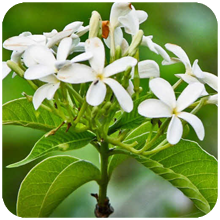
A deciduous small shrub or desiduous plant, having up to 13 m height with milky latex. Bark can be peeled in flakes and is gray to brown in color. The leaves are laminated on the upper surface and hairy on inferior surface, opposing subsessile and elliptical. The flowers are white, in corymbose cyme terminal, cylindrical fruits are dark gray with white spots, and occur in pairs; brown seeds, 0.5-1.5 cm long, with long tufts of hair.
Chemical composition – Contains alkaloids conessine (about 0.4%), conessimine, kurchin, conamine, conimine, conessidine, conarrhimine, holarrhimine, holarrhine and kurchicine. Steroidal alkaloids regholarrhenine A, B, C, D, E and F were isolated from the bark and antidysentericine from seeds.
Properties – Astringent, antidysenteric, anthelmintic, antibacterial, digestive, stomachic, febrifuge and tonic.
Recommendation – Chronic diarrhea, colic, dyspepsia, hemorrhoids, spleen and skin problems, amoebic dysentery, rectal problems such as painful defecation, rectal inflammation.
This plant is incorporated in natural remedy WORM END Syrup.




